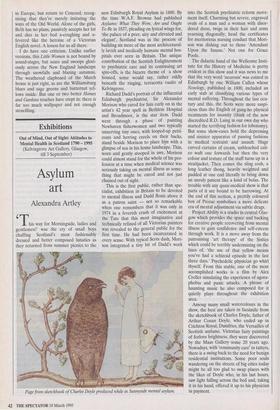Exhibitions
Out of Mind, Out of Sight: Attitudes to Mental Health in Scotland 1790 – 1995 (Kelvingrove Art Gallery, Glasgow, till 3 September)
Asylum art
Alexandra Artley
C This way for Morningside, ladies and gentlemen!' was the cry of small boys chaffing Scotland's most fashionably dressed and better composed lunatics as they returned from summer picnics to the new Edinburgh Royal Asylum in 1800. By the time W.A.F. Browne had published Asylums: What They Were, Are and Ought To Be in 1837, pleading on lyrical wings for, `the palace of a peer, airy and elevated and elegant', Scotland was in the process of building six more of the most architectural- ly lavish and medically humane mental hos- pitals ever seen in Britain. The unique contribution of the Scottish Enlightenment to psychiatric care and its continuing art spin-offs, is the bizarre theme of a show housed, some would say, rather oddly beneath the ringing, terracotta vaults of Kelvingrove. Richard Dadd's portrait of the influential Edinburgh psychiatrist, Sir Alexander Morison who cared for him early on in the artist's 42 year spell in Bethlem Hospital and Broadmoor, is the star item. Dadd went through a phase of painting Newhaven fisherwomen and two typically unnerving tiny ones, with looped-up petti- coats and herring creels on their backs, stand beside Morison to place him with a glimpse of sea in his home landscape. Thin, worn and gently stooped in awe, Morison could almost stand for the whole of his pro- fession at a time when medical science was seriously taking on mental illness as some- thing that might be cured and not just chained out of sight. This is the first public, rather than spe- cialist, exhibition in Britain to be devoted to mental illness and Dadd floats above it as a patron saint — not so remarkable when one remembers that it was only in 1974 in a feverish crush of excitement at the Tate that this most imaginative and technically refined of all Victorian painters was revealed to the general public for the first time. He had been incarcerated in every sense. With typical Scots dash, Mori- son integrated a tiny bit of Dadd's work Page from sketchbook of Charles Doyle produced while in Sunnyside mental asylum. into the Scottish psychiatric reform move- ment itself. Charming but severe, engraved ovals of a man and a woman with disor- dered dress, twigs in their hair and arms yearning diagonally, head the certificates for meritorious nursing conduct that Mori- son was dishing out to those 'Attendant Upon the Insane.' Not one for Grace Poole.
The didactic hand of the Wellcome Insti- tute for the History of Medicine is pretty evident in this show and it was news to me that the very word 'neurosis' was coined in Edinburgh by one William Cullen whose Nosology, published in 1800, included an early stab at classifying various types of mental suffering. Throughout the last cen- tury and this, the Scots were more suspi- cious than the English of gung-ho physical treatments for insanity (think of the now discredited R.D. Laing in our own day who started the terrifying fashion for lobotomy). But some show-cases hold the depressing and sinister apparatus of passing fashions in medical restraint and assault. Huge curved curtains of cream, unbleached cali- co waft one forwards but then the very colour and texture of the stuff turns up in a straitjacket. Then comes the sling cosh, a long leather thong, heavily weighted and padded at one end literally to bring down an unruly patient like a kind of bolas. The trouble with any quasi-medical show is that parts of it are bound to be harrowing. At the end of this section, a prettily coloured box of Prozac symbolises a more delicate era of mental adjustment via subtle drugs.
Project Ability is a studio in central Glas- gow which provides the space and backing for creative people recovering from mental illness to gain confidence and self-esteem through work. It is a move away from the patronising 'art therapy' of the Sixties which could be terribly undermining on the lines of, 'the use of that yellow means you've had a schizoid episode in the last three days.' Psychedelic physician go whirl thyself. From this stable, one of the most accomplished works is a film by Alex Croller simulating the experience of agora- phobia and panic attacks. A phrase of haunting music he also composed for it quietly plays throughout the exhibition area.
Among many small watercolours in the show, the best are taken in facsimile from the sketchbook of Charles Doyle, father of Arthur Conan Doyle, who ended up in Crichton Royal, Dumfries, the Versailles of Scottish asylums. Victorian fairy paintings of forlorn brightness, they were discovered by the Maas Gallery some 20 years ago. Nowadays, with 'community care' in tatters, there is a swing back to the need for benign residential institutions. Some poor souls wandering on the streets of big cities today might be all too glad to swap places with the likes of Doyle who, in his last hours, saw light falling across the bed and, taking it in his hand, offered it up to his physician in payment.


























































 Previous page
Previous page